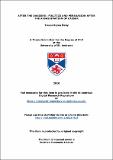Files in this item
After the daggers : politics and persuasion after the assassination of Caesar
Item metadata
| dc.contributor.advisor | Smith, Christopher John | |
| dc.contributor.advisor | Woolf, Greg | |
| dc.contributor.author | Mahy, Trevor Bryan | |
| dc.coverage.spatial | x + 340 | en_US |
| dc.date.accessioned | 2010-06-22T09:33:45Z | |
| dc.date.available | 2010-06-22T09:33:45Z | |
| dc.date.issued | 2010-06-22 | |
| dc.identifier | uk.bl.ethos.552398 | |
| dc.identifier.uri | https://hdl.handle.net/10023/928 | |
| dc.description.abstract | In this thesis, I examine the nature and role of persuasion in Roman politics in the period immediately following the assassination of Caesar on the Ides of March 44 B.C. until the capture of the city of Rome by his heir Octavianus in August 43 B.C. The purpose of my thesis is to assess the extent to which persuasion played a critical role in political interactions and in the decision-making processes of those involved during this crucial period in Roman history. I do this by means of a careful discussion and analysis of a variety of different types of political interactions, both public and private. As regards the means of persuasion, I concentrate on the role and use of oratory in these political interactions. Consequently, my thesis owes much in terms of approach to the work of Millar (1998) and, more recently, Morstein-Marx (2004) on placing oratory at the centre of our understanding of how politics functioned in practice in the late Roman republic. Their studies, however, focus on the potential extent and significance of mass participation in the late Roman republican political system, and on the contio as the key locus of political interaction. In my thesis, I contribute to improving our new way of understanding late Roman republican politics by taking a broader approach that incorporates other types of political interactions in which oratory played a significant role. I also examine oratory as but one of a variety of means of persuasion in Roman political interactions. Finally, in analyzing politics and persuasion in the period immediately after Caesar’s assassination, I am examining not only a crucial period in Roman history, but one which is perhaps the best documented from the ancient world. The relative richness of contemporary evidence for this period calls out for the sort of close reading of sources and detailed analysis that I provide in my thesis that enables a better understanding of how politics actually played out in the late Roman republic. | en_US |
| dc.language.iso | en | en_US |
| dc.rights | Creative Commons Attribution-NonCommercial-NoDerivs 3.0 Unported | |
| dc.rights.uri | http://creativecommons.org/licenses/by-nc-nd/3.0/ | |
| dc.subject | Rome -- History -- Republic, 44 - 43 BC | en_US |
| dc.subject | Rome -- Politics & government -- Republic, 44 - 43 BC | en_US |
| dc.subject | Persuasion (Rhetoric) | en_US |
| dc.subject | Oratory, Ancient | en_US |
| dc.subject | Cicero, Marcus Tullius | en_US |
| dc.subject | Brutus, Marcus Iunius | en_US |
| dc.subject.lcc | DG268.M25 | |
| dc.subject.lcsh | Cicero, Marcus Tullius. Philippicae | en_US |
| dc.subject.lcsh | Persuasion (Rhetoric) | en_US |
| dc.subject.lcsh | Persuasion (Psychology) | en_US |
| dc.subject.lcsh | Persuasion (Psychology) | en_US |
| dc.subject.lcsh | Speeches, addresses, etc., Latin--History and criticism | en_US |
| dc.subject.lcsh | Communication in politics--Rome--History | en_US |
| dc.subject.lcsh | Public opinion--Rome | en_US |
| dc.subject.lcsh | Rome--History--Republic, 265-30 B.C. | en_US |
| dc.subject.lcsh | Rome--History--Augustus, 30 B.C.-14 A.D. | en_US |
| dc.subject.lcsh | Rome--Politics and government--265-30 B.C. | en_US |
| dc.title | After the daggers : politics and persuasion after the assassination of Caesar | en_US |
| dc.type | Thesis | en_US |
| dc.contributor.sponsor | Social Sciences and Humanities Research Council of Canada (SSHRC) | en_US |
| dc.contributor.sponsor | Ronald Morton Smith Scholarship Fund | en_US |
| dc.contributor.sponsor | Miller-Lyell Scholarship Fund | en_US |
| dc.contributor.sponsor | University of St Andrews | en_US |
| dc.type.qualificationlevel | Doctoral | en_US |
| dc.type.qualificationname | PhD Doctor of Philosophy | en_US |
| dc.publisher.institution | The University of St Andrews | en_US |
This item appears in the following Collection(s)
Except where otherwise noted within the work, this item's licence for re-use is described as Creative Commons Attribution-NonCommercial-NoDerivs 3.0 Unported
Items in the St Andrews Research Repository are protected by copyright, with all rights reserved, unless otherwise indicated.


